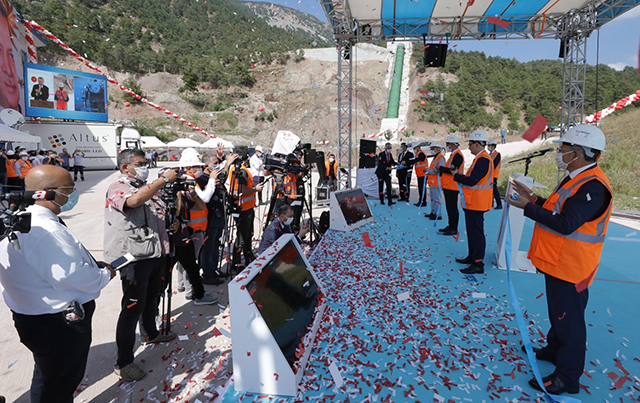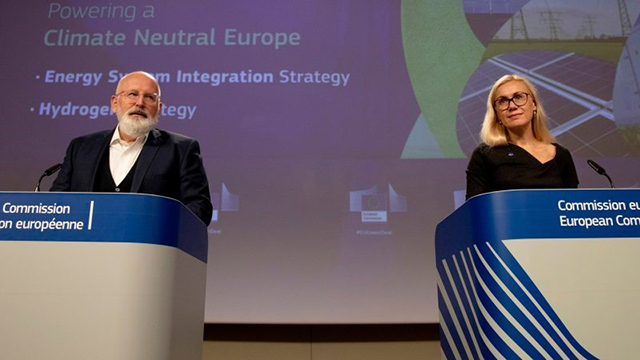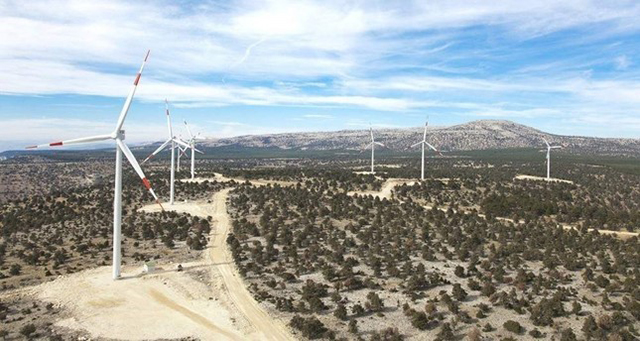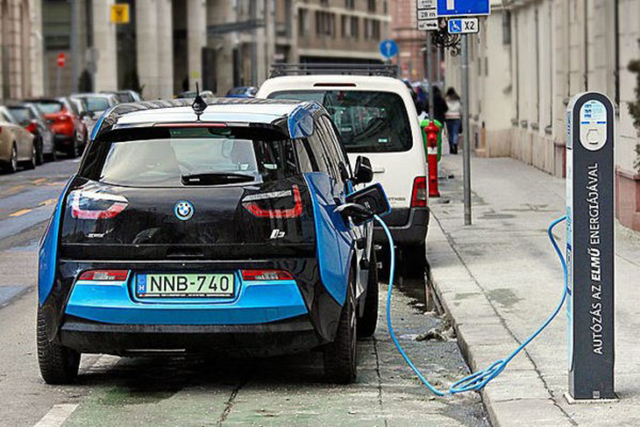
A total of 52 hydroelectricity power plants (HPP) with 1,439 megawatts (MW) total installed capacity began operation in the last two years, according to Turkey's Energy and Natural Resources Minister Fatih Donmez on Sunday.
Speaking at the opening ceremony of Tokat Niksar Akinci HPP in Turkey’s northern province of Tokat, Donmez said that nearly 11.3 billion Turkish Liras was invested in 52 new HPPs, located in 26 different cities of Turkey.
Donmez noted that the plants will provide electricity to around 1.85 million Turkish households.
"In the last 18 years, Turkey has become a rare success story in energy sector," Donmez said, adding that the country's installed power capacity reached more than 91,000 MW recently from around 31,000 MW in 2002.
"Additionally, the country shows more than 6% annual growth in installed capacity among the Organization for Economic Co-operation and Development (OECD) countries," he highlighted.
"With this growth in capacity, Turkey ranks in first place among all OECD countries," he asserted.
Donmez said that the Tokat Niksar Akinci HPP has 99 MW of installed capacity and annual electricity production is expected to reach 448 million kilowatthours (kWh).
"Akinci power plant will provide electricity need of 231,000 households," he noted.
In addition to production, the plant will help to reduce approximately 230 thousand tons of carbon dioxide per annum. He also stated that the construction of the plant provided employment opportunities to 600 citizens.
Meanwhile, according to the Turkey's Energy and Natural Resources Ministry, hydraulic resources, which hold the most important position in the renewable energy potential of Turkey, possess a hydroelectricity potential of 433 billion kWh, while the technically usable potential is 216 kWh, and the economic hydroelectricity potential is 140 billion kWh per year.
Source: Anadolu Agency

Turkey seeks 70% domestic production rate in its solar energy power plant tenders as part of the small-scale Energy Resource Areas (YEKA) project.
According to information compiled by Anadolu Agency (AA), the country will hold tenders for 74 power plants with a size ranging between 10, 15 and 20 megawatts (MW) of electricity.
The plants will be built in 36 designated provinces across Turkey.
The highest capacity allocation has been made to Turkey's southern coastal city of Antalya, the southeastern provinces of Mardin, Gaziantep and eastern Van province.
The localization rate for the solar panels that will be used at plants needs to be at least 70% and panels can be procured only from Turkish factories and manufacturers. The photovoltaic (PV) cells used in solar panels should also be produced entirely by domestic sources, Anadolu Agency (AA) reported.
The duration of licenses for small-scale YEKAs with a 10 MW capacity will be 30 years with an additional 18-month prelicense period. The duration of the construction of plants will also be a maximum of 18 months from the date when the license is awarded. The prelicense period for 15 and 20 MW capacity solar plants will be a maximum of 22 months.
Cem Ozkok, chairman of the board of directors of the Solar Energy Investors Association (GUYAD), said the localization requirements will accelerate developments in subsidiary industries.
Turkey has been working on reducing its dependence on energy imports and increasing production from natural resources. Authorities have tabbed YEKA sites as the basis of the country’s clean energy drive, increasing domestic production and strengthening local electricity generation capacity.
Turkey plans to boost its wind and solar capacity by 10,000 MW each year over the coming decade through YEKA.
Turkey held the first 1,000 MW solar power YEKA tender in March 2017. A consortium of Turkish Kalyon and South Korean Hanwha Group was awarded the contract for a $1.3 billion (TL 8.93 billion) project in the central Anatolian city of Konya. The feed-in tariff at the auction was set at $6.99 per kilowatt-hour (kWh).
The first 1,000 MW wind power YEKA contract was awarded to the Turkish-German consortium consisting of Kalyon-Turkerler-Siemens. The feed-in tariff was set at $3.48 per kWh, recorded as the lowest for similar projects around the world.
Source: Daily Sabah

The European Commission on Wednesday (8 July) unveiled its “energy system integration strategy” which aims to link different energy carriers, infrastructure and consumption sectors together in order to boost renewables and reduce carbon emissions.
The strategy aims to achieve deep decarbonisation at the “lowest possible costs” by minimising waste and using the relative strengths of different energy carriers such as electricity and decarbonised gases.
A quick and cost-effective decarbonisation requires a more integrated approach to planning and operating Europe’s energy system, EU climate chief Frans Timmermans said as he presented the strategy on Wednesday (8 July).
“In fact, we need to complete an overhaul of the current energy system which is quickly becoming a relic of the past,” Timmermans said.
“Today’s energy system is still built on several parallel, vertical energy value chains, which rigidly link specific energy resources with specific end-use sectors,” the policy document explains.
This is “way too wasteful and way too rigid to be fit for a sustainable future,” Timmermans said, describing a future energy system which is more agile and able to switch seamlessly across different energy carriers to achieve deeper emissions cuts in sectors like transport and industry, which are heavily dependent on fossil fuels.
“We need to break the silos between separate flows of energy production and use,” said Timmermans, adding that “we need to stop transferring the wrong energy carriers in the wrong way to end-users.”
The strategy does not contain legislative proposals; those will follow mainly next year, with a batch of new draft laws expected in June. But the policy document does set out “concrete steps to achieve these three goals,” said Kadri Simson, the EU’s energy commissioner.
“You cannot build the energy system of the future using the policies and frameworks of the past,” she said, citing the upcoming building renovation wave and offshore energy strategy, as well as the gas market review which is planned for 2021.
One of the key “enablers” to achieve this vision is the digitalisation of energy infrastructure – whether generation assets, gas pipelines, power lines, or buildings and factories on the consumer end –, EU officials explained.
“These infrastructures will have to be planned in an integrated way to use all the synergies across the different infrastructures,” said a senior Commission official.
“And we will need much more digitalisation, because otherwise all these smart systems cannot work together,” the official added.
Hydrogen will also play a central role in linking up different components of the energy system.
Source: Euractiv

The European Bank for Reconstruction and Development (EBRD) has unveiled an ambitious plan to scale up even further its climate and environmental finance and its work supporting a green, low-carbon and resilient future.
Already at the forefront of climate and environmental action, the EBRD is now considering a goal of devoting over 50 per cent of its annual investments to the green economy by 2025.
In addition to the aim of making more than 50 per cent of its financing green, the plan would target specific emission reductions over the next five years and set a date for a decision on when all the EBRD’s projects are aligned to the Paris Climate Agreement. The Bank’s Board of Directors approved the new Green Economy Transition plan at its meeting on 8 July. This plan forms part of the EBRD’s overall strategy for the next five years and will become effective with this strategy, due for approval by shareholders at the Bank’s Annual Meeting, scheduled for 7-8 October.
The plan to become a majority green bank by 2025 builds on success in the past five years, during which the average green finance ratio rose to 40 from 25 per cent. The EBRD launched its Green Economy Transition (GET) approach in 2015 in the run-up to the Paris climate talks at the end of that year. The scaled-up approach (GET 2.1) defines clear action areas to support a green economic recovery in its regions of operations taking account of the impact of the coronavirus pandemic. Under GET 2.1, the EBRD would also step up policy work to ensure its 38 emerging economies can effectively achieve climate and environmental goals.
It would scale up investment by innovating across a set of specific environmental and climate mitigation and adaptation thematic areas such as greening the financial sector and energy systems, industrial decarbonisation, sustainable cities, food systems and connectivity, and natural capital preservation. In developing these thematic areas, particular attention would be given to just transition, gender considerations, circular economy opportunities, green digital solutions and the role of energy efficiency.
And, as climate change mitigation is a key GET 2.1 objective, the Bank would seek to achieve cumulative greenhouse gas (GHG) emissions reduction of 25 to 40 million tonnes per year by 2025. As part of GET 2.1, the EBRD would screen all investments for alignment with the Paris Agreement and national climate-related action plans, taking into consideration the priorities set in country and sector strategies. It would also increase its capacity to support countries, regions and sectors to develop low carbon and climate resilience strategies and scale up its efforts to mobilise climate finance.
The EBRD would work towards full alignment with the Paris Agreement, on which a decision would be taken no later than 2022, taking into account the lessons learned from the initial phase of implementation of the methodology jointly developed by the Multilateral Development Banks.
Source: EBRD

New car registrations in Germany fell 35 percent in the first half of 2020 to 1.21 million cars, reaching the lowest level since German reunification 30 years ago, according to the German Association of the Automotive Industry (VDA).
Exports and production declined by 40 percent each compared to the same period a year ago. The commercial vehicle sector is expected to be even worse hit, with a 29 percent decline in the full-year sales forecast in Germany and a 35 percent drop in Western Europe.
"The slump in the markets is unprecedented in its magnitude and global scale,” said VDA President Hildegard Muller. While a slight recovery is expected in the second half of the year, it will not be enough to prevent job losses, particularly among suppliers, the VDA added. Germany is expected to see a 23 percent drop in new car registrations to 2.8 million in all of 2020. In Europe, the VDA forecasts a 24 percent decline for the full year, while the global car market is expected to fall by 17 percent to 65.9 million units.
Demand for electric cars is growing, however, Henrik Mortsiefer writes in Der Tapesspiegel, citing figures published today by Germany’s Association of International Motor Vehicle Manufacturers (VDIK). The association expects more than 90,000 newly registered electric vehicles in the first half of the year, an increase of some 90 percent, including more than 43,000 battery-electric drive cars (a plus of 40 percent) and some 47,000 plug-in hybrids (a 190 percent increase). As part of Germany’s COVID-19 recovery stimulus programme, the government has doubled e-car buyer premiums from 3,000 to 6,000 euros in an effort to increase the number of e-cars on the road. The shift to low-carbon mobility in Germany has been slow so far although the country's world-renowned carmakers are now all betting on electric vehicles. However, so far transport emissions have remained stubbornly high.
Source: Clean Energy Wire

China will build six to eight nuclear reactors a year between 2020 and 2025 and raise total capacity to 70 gigawatts (GW), up 43.5 per cent compared to the end of May, the official China Daily said on Thursday (Jul 9), citing the country's nuclear association.
The China Nuclear Energy Association said the country's total installed nuclear capacity is expected to stand at 52GW by the end of 2020, falling short of a 58GW target.
But it would soon get back on track and could bring total capacity either in operation or under construction to around 200GW by 2035, the association was quoted as saying.
China's nuclear energy ambitions have been held back by delays on major projects involving previously untested technology, as well as a four-year moratorium on new approvals following the Fukushima disaster in Japan in 2011.
Government officials said in April the nuclear industry would not be affected by the coronavirus outbreak, but no new reactors have been given the go-ahead this year. Six were approved in 2019.
China's nuclear capacity stood at 48.8GW at end-May, accounting for 2.5 per cent of its total generation capacity, according to figures from the National Energy Administration.
Source: Channel News Asia
Cyber Resilience in the Electricity Ecosystem: Playbook for Boards and Cybersecurity Officers
Maintaining cyber resilience across the ecosystem is a challenge for all organizations and a significant priority for critical infrastructure sectors such as electricity. Furthermore, the COVID-19 crisis is having a dramatic impact on our society and has forced everyone to become heavily reliant on the internet and its digital economy.
Please click here to read the full report.

